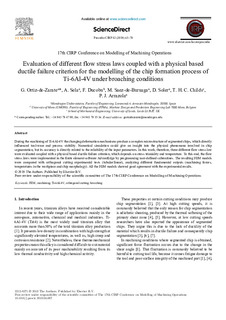Izenburua
Evaluation of different flow stress laws coupled with a physical based ductile failure criterion for the modelling of the chip formation process of Ti-6Al-4V under broaching conditionsBeste instituzio
Université de Mons (Bélgica)University of Leeds
Bertsioa
Bertsio argitaratua
Eskubideak
© 2019 The AuthorsSarbidea
Sarbide irekiaArgitaratzailearen bertsioa
https://doi.org/10.1016/j.procir.2019.04.067Non argitaratua
Procedia CIRP. Vol. 82. Pp. 65-70. Available online 5 July, 2019Argitaratzailea
ElsevierGako-hitzak
FEM
machining
Ti-6Al-4V
orhtogonal cutting ... [+]
machining
Ti-6Al-4V
orhtogonal cutting ... [+]
FEM
machining
Ti-6Al-4V
orhtogonal cutting
Broaching [-]
machining
Ti-6Al-4V
orhtogonal cutting
Broaching [-]
Laburpena
During the machining of Ti-6Al-4V the changing deformation mechanisms produce a complex microstructure of segmented chips, which directly influenced tool-wear and process stability. Numerical simulati ... [+]
During the machining of Ti-6Al-4V the changing deformation mechanisms produce a complex microstructure of segmented chips, which directly influenced tool-wear and process stability. Numerical simulation could give an insight into the physical phenomena involved in chip segmentation, but its accuracy is directly related to the reliability of the input parameters. In this work, therefore, three different flow stress law were evaluated coupled with a physical based ductile failure criterion, which depends on stress triaxiality and temperature. To this end, the flow stress laws were implemented in the finite element software AdvantEdge by programming user-defined subroutines. The resulting FEM models were compared with orthogonal cutting experimental tests (tubular/linear), analyzing different fundamental outputs (machining forces, temperatures in the workpiece and chip morphology). All the FEM models showed good agreement with the experimental results. [-]
Sponsorship
Gobierno VascoProjectu ID
info:eu-repo/grantAgreement/GV/Convocatoria Universidad Empresa 2016-2017/UE2016-07/CAPV/Influencia del material pieza, condiciones de corte y herramienta en la condición de integridad superficial del material pieza y vida de herramienta resultante en el proceso de brochado de componentes aeronáuticos/AEROBROCHBildumak
Item honek honako baimen-fitxategi hauek dauzka asoziatuta:























